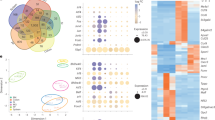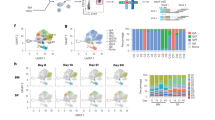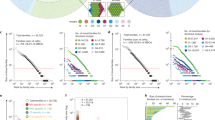Abstract
Plasma cells are unique immune effectors, capable of producing large amounts of high-affinity antibodies that protect against pathogenic infections. Although most plasma cells have short lifespans, certain conditions or vaccinations can give rise to long-lived plasma cells (LLPCs) that provide individuals with lifelong protection against pathogen exposure. The nature of these LLPCs is poorly understood; however, recent studies have shed new light on the ontogeny, diversity, maturation and survival of these unique cells. Whereas LLPCs had been thought to arise preferentially from germinal centres, novel genetic tools have revealed that they can originate from various stages throughout the humoral response. Furthermore, new single-cell analyses have shown that mouse and human plasma cells are heterogeneous and may undergo further maturation in situ in the bone marrow niche. Finally, plasma cells were previously considered to be sessile cells maintained in fixed survival niches, but new data show that plasma cell subsets can differentially migrate and organize into clusters that may be associated with survival niches. These descriptive findings provide new insights into how cell-intrinsic programmes and extrinsic factors may regulate the longevity of plasma cells in various contexts, which suggest new research avenues for their functional validation.
This is a preview of subscription content, access via your institution
Access options
Access Nature and 54 other Nature Portfolio journals
Get Nature+, our best-value online-access subscription
$29.99 / 30 days
cancel any time
Subscribe to this journal
Receive 12 print issues and online access
$209.00 per year
only $17.42 per issue
Buy this article
- Purchase on Springer Link
- Instant access to full article PDF
Prices may be subject to local taxes which are calculated during checkout


Similar content being viewed by others
References
Jing, Z. et al. Fine-tuning spatial–temporal dynamics and surface receptor expression support plasma cell-intrinsic longevity. eLife 12, RP89712 (2023).
Koike, T. et al. Progressive differentiation toward the long-lived plasma cell compartment in the bone marrow. J. Exp. Med. 220, e20221717 (2023).
Liu, X., Yao, J., Zhao, Y., Wang, J. & Qi, H. Heterogeneous plasma cells and long-lived subsets in response to immunization, autoantigen and microbiota. Nat. Immunol. 23, 1564–1576 (2022).
Robinson, M. J. et al. Intrinsically determined turnover underlies broad heterogeneity in plasma-cell lifespan. Immunity 56, 1596–1612.e4 (2023).
Amanna, I. J., Carlson, N. E. & Slifka, M. K. Duration of humoral immunity to common viral and vaccine antigens. N. Engl. J. Med. 357, 1903–1915 (2007).
Robinson, M. J., Webster, R. H. & Tarlinton, D. M. How intrinsic and extrinsic regulators of plasma cell survival might intersect for durable humoral immunity. Immunol. Rev. 296, 87–103 (2020).
Slifka, M. K., Antia, R., Whitmire, J. K. & Ahmed, R. Humoral immunity due to long-lived plasma cells. Immunity 8, 363–372 (1998).
Manz, R. A., Thiel, A. & Radbruch, A. Lifetime of plasma cells in the bone marrow. Nature 388, 133–134 (1997).
Bortnick, A. et al. Long-lived bone marrow plasma cells are induced early in response to T cell-independent or T cell-dependent antigens. J. Immunol. 188, 5389–5396 (2012).
Robinson, M. J. et al. Long-lived plasma cells accumulate in the bone marrow at a constant rate from early in an immune response. Sci. Immunol. 7, eabm8389 (2022).
Xu, A. Q., Barbosa, R. R. & Calado, D. P. Genetic timestamping of plasma cells in vivo reveals tissue-specific homeostatic population turnover. eLife 9, e59850 (2020).
Phan, T. G., Grigorova, I., Okada, T. & Cyster, J. G. Subcapsular encounter and complement-dependent transport of immune complexes by lymph node B cells. Nat. Immunol. 8, 992–1000 (2007).
Carrasco, Y. R. & Batista, F. D. B cells acquire particulate antigen in a macrophage-rich area at the boundary between the follicle and the subcapsular sinus of the lymph node. Immunity 27, 160–171 (2007).
Okada, T. & Cyster, J. G. B cell migration and interactions in the early phase of antibody responses. Curr. Opin. Immunol. 18, 278–285 (2006).
Akkaya, M. et al. Second signals rescue B cells from activation-induced mitochondrial dysfunction and death. Nat. Immunol. 19, 871–884 (2018).
Halliley, J. L. et al. Long-lived plasma cells are contained within the CD19−CD38hiCD138+ subset in human bone marrow. Immunity 43, 132–145 (2015).
Elsner, R. A. & Shlomchik, M. J. Germinal center and extrafollicular B cell responses in vaccination, immunity, and autoimmunity. Immunity 53, 1136–1150 (2020).
Smith, K. G., Light, A., Nossal, G. J. & Tarlinton, D. M. The extent of affinity maturation differs between the memory and antibody-forming cell compartments in the primary immune response. EMBO J. 16, 2996–3006 (1997).
Phan, T. G. et al. High affinity germinal center B cells are actively selected into the plasma cell compartment. J. Exp. Med. 203, 2419–2424 (2006).
Weisel, F. J., Zuccarino-Catania, G. V., Chikina, M. & Shlomchik, M. J. A temporal switch in the germinal center determines differential output of memory B and plasma cells. Immunity 44, 116–130 (2016).
Fidler, J. M. In vivo immune response to TNP hapten coupled to thymus-independent carrier lipopolysaccharide. Cell. Immunol. 16, 223–236 (1975).
Taillardet, M. et al. The thymus-independent immunity conferred by a pneumococcal polysaccharide is mediated by long-lived plasma cells. Blood 114, 4432–4440 (2009).
Jing, Z., McCarron, M. J., Dustin, M. L. & Fooksman, D. R. Germinal center expansion but not plasmablast differentiation is proportional to peptide-MHCII density via CD40-CD40L signaling strength. Cell Rep. 39, 110763 (2022).
Lee, J. H. et al. Long-primed germinal centres with enduring affinity maturation and clonal migration. Nature 609, 998–1004 (2022).
Kim, W. et al. Germinal centre-driven maturation of B cell response to mRNA vaccination. Nature 604, 141–145 (2022).
Hagglof, T. et al. Continuous germinal center invasion contributes to the diversity of the immune response. Cell 186, 147–161.e15 (2023).
de Carvalho, R. V. H. et al. Clonal replacement sustains long-lived germinal centers primed by respiratory viruses. Cell 186, 131–146.e13 (2023).
Schaefer-Babajew, D. et al. Antibody feedback regulates immune memory after SARS-CoV-2 mRNA vaccination. Nature 613, 735–742 (2023).
Gaudette, B. T. et al. Resting innate-like B cells leverage sustained Notch2/mTORC1 signaling to achieve rapid and mitosis-independent plasma cell differentiation. J. Clin. Invest. 131, e151975 (2021).
Smith, F. L. et al. B-1 plasma cells require non-cognate CD4 T cell help to generate a unique repertoire of natural IgM. J. Exp. Med. 220, e20220195 (2023).
Baumgarth, N. B-1 cell heterogeneity and the regulation of natural and antigen-induced IgM production. Front. Immunol. 7, 324 (2016).
Foote, J. B., Mahmoud, T. I., Vale, A. M. & Kearney, J. F. Long-term maintenance of polysaccharide-specific antibodies by IgM-secreting cells. J. Immunol. 188, 57–67 (2012).
Reynolds, A. E., Kuraoka, M. & Kelsoe, G. Natural IgM is produced by CD5− plasma cells that occupy a distinct survival niche in bone marrow. J. Immunol. 194, 231–242 (2015).
Vergani, S. et al. A self-sustaining layer of early-life-origin B cells drives steady-state IgA responses in the adult gut. Immunity 55, 1829–1842.e6 (2022).
Bernasconi, N. L., Traggiai, E. & Lanzavecchia, A. Maintenance of serological memory by polyclonal activation of human memory B cells. Science 298, 2199–2202 (2002).
Ahuja, A., Anderson, S. M., Khalil, A. & Shlomchik, M. J. Maintenance of the plasma cell pool is independent of memory B cells. Proc. Natl Acad. Sci. USA 105, 4802–4807 (2008).
DiLillo, D. J. et al. Maintenance of long-lived plasma cells and serological memory despite mature and memory B cell depletion during CD20 immunotherapy in mice. J. Immunol. 180, 361–371 (2008).
Hammarlund, E. et al. Plasma cell survival in the absence of B cell memory. Nat. Commun. 8, 1781 (2017).
Langley, W. A. et al. Persistence of virus-specific antibody after depletion of memory B cells. J. Virol. 96, e0002622 (2022).
Pescovitz, M. D. et al. Effect of rituximab on human in vivo antibody immune responses. J. Allergy Clin. Immunol. 128, 1295–1302.e5 (2011).
Jergovic, M. et al. Infection-induced type I interferons critically modulate the homeostasis and function of CD8+ naive T cells. Nat. Commun. 12, 5303 (2021).
Zuccarino-Catania, G. V. et al. CD80 and PD-L2 define functionally distinct memory B cell subsets that are independent of antibody isotype. Nat. Immunol. 15, 631–637 (2014).
Pape, K. A., Taylor, J. J., Maul, R. W., Gearhart, P. J. & Jenkins, M. K. Different B cell populations mediate early and late memory during an endogenous immune response. Science 331, 1203–1207 (2011).
Weisel, N. M. et al. Surface phenotypes of naive and memory B cells in mouse and human tissues. Nat. Immunol. 23, 135–145 (2022).
Johnson, J. L. et al. The transcription factor T-bet resolves memory B cell subsets with distinct tissue distributions and antibody specificities in mice and humans. Immunity 52, 842–855.e6 (2020).
Stone, S. L. et al. T-bet transcription factor promotes antibody-secreting cell differentiation by limiting the inflammatory effects of IFN-γ on B cells. Immunity 50, 1172–1187.e7 (2019).
Nellore, A. et al. A transcriptionally distinct subset of influenza-specific effector memory B cells predicts long-lived antibody responses to vaccination in humans. Immunity 56, 847–863.e8 (2023).
Myles, A., Sanz, I. & Cancro, M. P. T-bet+ B cells: a common denominator in protective and autoreactive antibody responses? Curr. Opin. Immunol. 57, 40–45 (2019).
O’Connor, B. P., Cascalho, M. & Noelle, R. J. Short-lived and long-lived bone marrow plasma cells are derived from a novel precursor population. J. Exp. Med. 195, 737–745 (2002).
Chernova, I. et al. Lasting antibody responses are mediated by a combination of newly formed and established bone marrow plasma cells drawn from clonally distinct precursors. J. Immunol. 193, 4971–4979 (2014).
Nutt, S. L., Taubenheim, N., Hasbold, J., Corcoran, L. M. & Hodgkin, P. D. The genetic network controlling plasma cell differentiation. Semin. Immunol. 23, 341–349 (2011).
Lam, W. Y. et al. Metabolic and transcriptional modules independently diversify plasma cell lifespan and function. Cell Rep. 24, 2479–2492.e6 (2018).
Underhill, G. H., George, D., Bremer, E. G. & Kansas, G. S. Gene expression profiling reveals a highly specialized genetic program of plasma cells. Blood 101, 4013–4021 (2003).
Tarte, K., Zhan, F., De Vos, J., Klein, B. & Shaughnessy, J. Jr. Gene expression profiling of plasma cells and plasmablasts: toward a better understanding of the late stages of B-cell differentiation. Blood 102, 592–600 (2003).
Joyner, C. J. et al. Generation of human long-lived plasma cells by developmentally regulated epigenetic imprinting. Life Sci. Alliance 5, e202101285 (2022).
Duan, M. et al. Understanding heterogeneity of human bone marrow plasma cell maturation and survival pathways by single-cell analyses. Cell Rep. 42, 112682 (2023).
Higgins, B. W. et al. Isotype-specific plasma cells express divergent transcriptional programs. Proc. Natl Acad. Sci. USA 119, e2121260119 (2022).
Brynjolfsson, S. F., Mohaddes, M., Karrholm, J. & Wick, M. J. Long-lived plasma cells in human bone marrow can be either CD19+ or CD19−. Blood Adv. 1, 835–838 (2017).
Akhmetzyanova, I. et al. Dynamic CD138 surface expression regulates switch between myeloma growth and dissemination. Leukemia 34, 245–256 (2020).
Hamaidi, I. et al. Sirt2 inhibition enhances metabolic fitness and effector functions of tumor-reactive T cells. Cell Metab. 32, 420–436.e12 (2020).
Chevrier, S. et al. CD93 is required for maintenance of antibody secretion and persistence of plasma cells in the bone marrow niche. Proc. Natl Acad. Sci. USA 106, 3895–3900 (2009).
Nie, Y. et al. The role of CXCR4 in maintaining peripheral B cell compartments and humoral immunity. J. Exp. Med. 200, 1145–1156 (2004).
Slocombe, T. et al. Plasma cell homeostasis: the effects of chronic antigen stimulation and inflammation. J. Immunol. 191, 3128–3138 (2013).
Benson, M. J. et al. Cutting edge: the dependence of plasma cells and independence of memory B cells on BAFF and APRIL. J. Immunol. 180, 3655–3659 (2008).
Cassese, G. et al. Plasma cell survival is mediated by synergistic effects of cytokines and adhesion-dependent signals. J. Immunol. 171, 1684–1690 (2003).
Tangye, S. G. Staying alive: regulation of plasma cell survival. Trends Immunol. 32, 595–602 (2011).
Belnoue, E. et al. Homing and adhesion patterns determine the cellular composition of the bone marrow plasma cell niche. J. Immunol. 188, 1283–1291 (2012).
Wilmore, J. R. & Allman, D. Here, there, and anywhere? Arguments for and against the physical plasma cell survival niche. J. Immunol. 199, 839–845 (2017).
Benet, Z., Jing, Z. & Fooksman, D. R. Plasma cell dynamics in the bone marrow niche. Cell Rep. 34, 108733 (2021).
Fooksman, D. R. et al. Development and migration of plasma cells in the mouse lymph node. Immunity 33, 118–127 (2010).
Hauser, A. E. et al. Chemotactic responsiveness toward ligands for CXCR3 and CXCR4 is regulated on plasma blasts during the time course of a memory immune response. J. Immunol. 169, 1277–1282 (2002).
Aaron, T. S. & Fooksman, D. R. Dynamic organization of the bone marrow plasma cell niche. FEBS J. 289, 4228–4239 (2022).
Wilmore, J. R. et al. IgA plasma cells are long-lived residents of gut and bone marrow that express isotype- and tissue-specific gene expression patterns. Front. Immunol. 12, 791095 (2021).
Holt, P. G., Sedgwick, J. D., O’Leary, C., Krska, K. & Leivers, S. Long-lived IgE- and IgG-secreting cells in rodents manifesting persistent antibody responses. Cell. Immunol. 89, 281–289 (1984).
Xiong, S., Jia, Y. & Liu, C. IgE-expressing long-lived plasma cells in persistent sensitization. Front. Pediatr. 10, 979012 (2022).
Pangrazzi, L. et al. “Inflamm-aging” influences immune cell survival factors in human bone marrow. Eur. J. Immunol. 47, 481–492 (2017).
Ho, Y. H. et al. Remodeling of bone marrow hematopoietic stem cell niches promotes myeloid cell expansion during premature or physiological aging. Cell Stem Cell 25, 407–418.e6 (2019).
Gatto, D. et al. Regulation of memory antibody levels: the role of persisting antigen versus plasma cell life span. J. Immunol. 178, 67–76 (2007).
Wilmore, J. R. et al. Commensal microbes induce serum IgA responses that protect against polymicrobial sepsis. Cell Host Microbe 23, 302–311.e3 (2018).
Tarlinton, D. M., Ding, Z., Tellier, J. & Nutt, S. L. Making sense of plasma cell heterogeneity. Curr. Opin. Immunol. 81, 102297 (2023).
Aaron, T. et al. TNF-α limits serological memory by disrupting the bone marrow niche. J. Immunol. 210, 595–608 (2023).
Mina, M. J. et al. Measles virus infection diminishes preexisting antibodies that offer protection from other pathogens. Science 366, 599–606 (2019).
Odendahl, M. et al. Generation of migratory antigen-specific plasma blasts and mobilization of resident plasma cells in a secondary immune response. Blood 105, 1614–1621 (2005).
Radbruch, A. et al. Competence and competition: the challenge of becoming a long-lived plasma cell. Nat. Rev. Immunol. 6, 741–750 (2006).
Gonzalez-Garcia, I., Ocana, E., Jimenez-Gomez, G., Campos-Caro, A. & Brieva, J. A. Immunization-induced perturbation of human blood plasma cell pool: progressive maturation, IL-6 responsiveness, and high PRDI-BF1/BLIMP1 expression are critical distinctions between antigen-specific and nonspecific plasma cells. J. Immunol. 176, 4042–4050 (2006).
Suematsu, S. et al. IgG1 plasmacytosis in interleukin 6 transgenic mice. Proc. Natl Acad. Sci. USA 86, 7547–7551 (1989).
Markine-Goriaynoff, D., Nguyen, T. D., Bigaignon, G., Van Snick, J. & Coutelier, J. P. Distinct requirements for IL-6 in polyclonal and specific Ig production induced by microorganisms. Int. Immunol. 13, 1185–1192 (2001).
Minges Wols, H. A., Underhill, G. H., Kansas, G. S. & Witte, P. L. The role of bone marrow-derived stromal cells in the maintenance of plasma cell longevity. J. Immunol. 169, 4213–4221 (2002).
O’Connor, B. P. et al. BCMA is essential for the survival of long-lived bone marrow plasma cells. J. Exp. Med. 199, 91–98 (2004).
Mattioli, C. A. & Tomasi, T. B. Jr. The life span of IgA plasma cells from the mouse intestine. J. Exp. Med. 138, 452–460 (1973).
Lemke, A. et al. Long-lived plasma cells are generated in mucosal immune responses and contribute to the bone marrow plasma cell pool in mice. Mucosal Immunol. 9, 83–97 (2016).
Acknowledgements
This work was supported (in part) by the Intramural Research Program of the US National Institutes of Health (to Z.J.), R01HL141491 (to D.R.F) and the Irma T. Hirschl/Monique Weill-Caulier Trusts Research Award (to D.R.F.).
Author information
Authors and Affiliations
Contributions
The authors contributed equally to all aspects of the article. All authors researched data for the article. All authors contributed substantially to discussion of the content. All authors wrote the article. D.R.F. reviewed and/or edited the manuscript before submission.
Corresponding author
Ethics declarations
Competing interests
The authors declare no competing interests.
Peer review
Peer review information
Nature Reviews Immunology thanks the anonymous reviewers for their contribution to the peer review of this work.
Additional information
Publisher’s note Springer Nature remains neutral with regard to jurisdictional claims in published maps and institutional affiliations.
Rights and permissions
Springer Nature or its licensor (e.g. a society or other partner) holds exclusive rights to this article under a publishing agreement with the author(s) or other rightsholder(s); author self-archiving of the accepted manuscript version of this article is solely governed by the terms of such publishing agreement and applicable law.
About this article
Cite this article
Fooksman, D.R., Jing, Z. & Park, R. New insights into the ontogeny, diversity, maturation and survival of long-lived plasma cells. Nat Rev Immunol (2024). https://doi.org/10.1038/s41577-024-00991-0
Accepted:
Published:
DOI: https://doi.org/10.1038/s41577-024-00991-0



